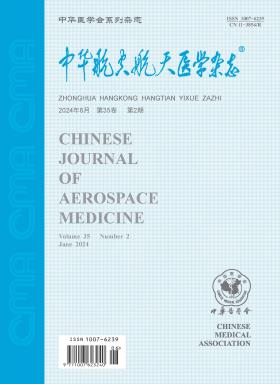战斗机飞行员颈部疼痛及其对作战飞行影响的调查研究
引用次数: 0
摘要
目的了解战斗机飞行员日常颈痛(DNP)和飞行相关性颈痛(FNP)的患病率,探讨颈部症状对战斗机飞行员作战飞行的影响,为进一步研究危险因素和预防措施提供基础数据。方法对233名歼击机飞行员(94名高性能歼击机飞行员和139名常规歼击机飞行员)近1年自我报告的DNP和FNP患病率进行调查。根据DNP的患病率将飞行员分为DNP组和健康组,比较两组之间的FNP患病率。比较了高性能战斗机飞行员和常规战斗机飞行员DNP和FNP的患病率。飞行员还描述了FNP如何影响作战飞行。结果32.6%的飞行员经历过DNP, 59.7%的飞行员经历过FNP, 17.2%的飞行员经历过频繁FNP。DNP飞行员FNP和FNP发生率均高于健康飞行员(χ2=41.665、54.669,P<0.01)。与常规战斗机飞行员相比,高性能战斗机飞行员DNP和FNP患病率无统计学差异,但FNP频次患病率有统计学差异(χ2=7.753, P<0.01)。在患有FNP的飞行员中,18.7%的人表示颈部疼痛影响飞行耐力,20.1%的人表示注意力集中或耐力受到影响,37.4%的人表示观察或目标搜索能力受到影响,59.7%的人表示敏捷操作或大G机动受到影响。在有FNP的高性能战斗机飞行员中,67.8%的人报告说FNP导致了空战机动受限。结论战斗机飞行员日常颈痛和飞行相关颈痛的患病率相当高。日常颈部疼痛的飞行员更容易出现与飞行有关的颈部疼痛,这表明他们的颈部功能正在逐渐减弱,需要及时有效的干预。高性能战斗机飞行员更容易经历频繁的与飞行有关的颈部疼痛。与苍蝇有关的颈部疼痛在很多方面影响着飞行操作。这些发现突出了高性能战斗机飞行员对颈部功能的更严格要求和对空中服务的必要支持。关键词:颈部疼痛;患病率;流行病学研究;航空;飞行员本文章由计算机程序翻译,如有差异,请以英文原文为准。
Survey study on the neck pain in fighter pilots and its influences to operational flying
Objective
To investigate the prevalence of daily neck pain (DNP) and fly-related neck pain(FNP) in fighter pilots and to estimate how neck symptoms influenced operational flying in fighter pilots, so as to provide elementary data for further investigation of risk factors and preventive measure.
Methods
Two hundred and thirty-three fighter pilots, including 94 high-performance fighter pilots and 139 conventional fighter pilots, were surveyed on self-reported prevalence of DNP and FNP in past 1-yr. The pilots were grouped into with DNP and healthy groups by prevalence of DNP, and the FNP prevalence was compared between these two groups. The prevalences of DNP and FNP were compared between high-performance fighter pilots and conventional fighter pilots. Pilots also described how FNP influenced operational flying.
Results
Among all pilots, 32.6% had experienced DNP, 59.7% had experienced FNP and 17.2% had experienced frequent FNP. DNP pilots had statistically higher FNP and frequent FNP prevalence than healthy pilots (χ2=41.665, 54.669, P<0.01). Comparing with conventional fighter pilots, high performance fighter pilots had no statistically different DNP and FNP prevalence, but had statistically different frequent FNP prevalence(χ2=7.753, P<0.01). Among the pilots with FNP, 18.7% reported neck pain impacted flying endurance, 20.1% reported impacted ability of concentration or stamina, 37.4% reported impacted ability of observation or target searching, 59.7% reported impacted agile operation or high G maneuvers. Among high performance fighter pilots with FNP, 67.8% reported restricted air combat maneuvers resulted from FNP.
Conclusions
Prevalence of daily neck pain and fly-related neck pain are considerably high in fighter pilots. Pilots with daily neck pain are more easily to experience fly-related neck pain, indicating that their neck functions are steadily weakened and require prompt and effective intervention. High performance fighter pilots are more easily to experience frequent fly-related neck pain. The fly-related neck pain affects operational flying in many ways. Those findings highlight the stricter demand of neck function for high performance fighter pilots and the necessary support to air service.
Key words:
Neck pain; Prevalence; Epidemiologic studies; Aviation; Pilots
求助全文
通过发布文献求助,成功后即可免费获取论文全文。
去求助
来源期刊

中华航空航天医学杂志
航空航天医学
自引率
0.00%
发文量
2962
期刊介绍:
The aim of Chinese Journal of Aerospace Medicine is to combine theory and practice, improve and popularize, actively advocate a hundred flowers bloom and a hundred schools of thought contend, advocate seeking truth from facts, promote the development of the related disciplines of aerospace medicine and human efficiency, and promote the exchange and penetration of aerospace medicine and human efficiency with other biomedical and engineering specialties.
Topics of interest for Chinese Journal of Aerospace Medicine include:
-The content of the journal belongs to the discipline of special medicine and military medicine, with the characteristics of multidisciplinary synthesis and cross-penetration, and mainly reflected in the aerospace industry, aerospace flight safety and efficiency, as well as the synthesis of special medicine, preventive medicine, environmental medicine, psychology, etc.
-Military aeromedicine (Air Force, Navy and Army aeromedicine) and civil aeromedicine, with a balance of aerospace medicine are the strengths of the journal.
-The change in aerospace medicine from a focus on promoting physiological compensatory adaptations to enhancing human performance under extreme environmental conditions is what the journal is helping to promote.
-The expansion of manuscripts in high altitude medicine is also a special emphasis of the journal.
 求助内容:
求助内容: 应助结果提醒方式:
应助结果提醒方式:


